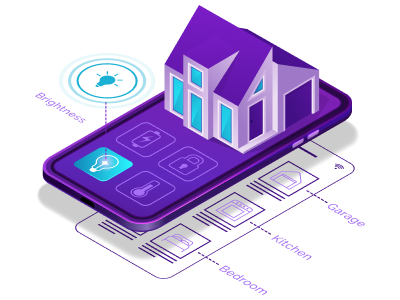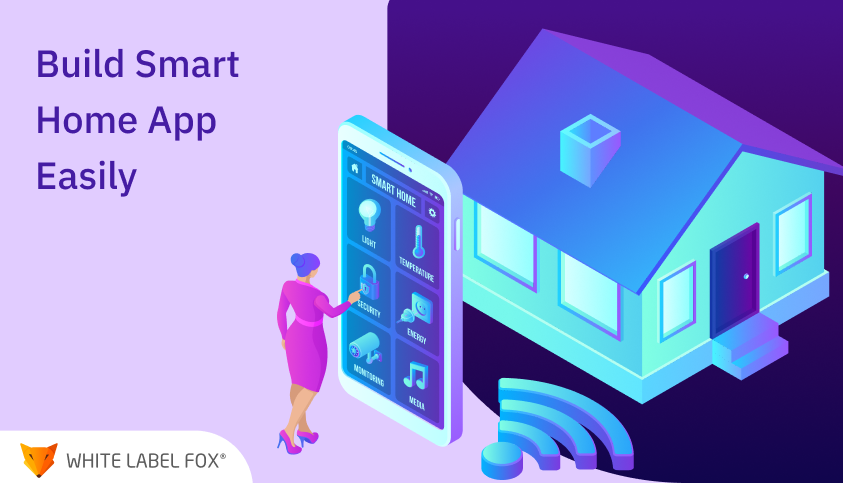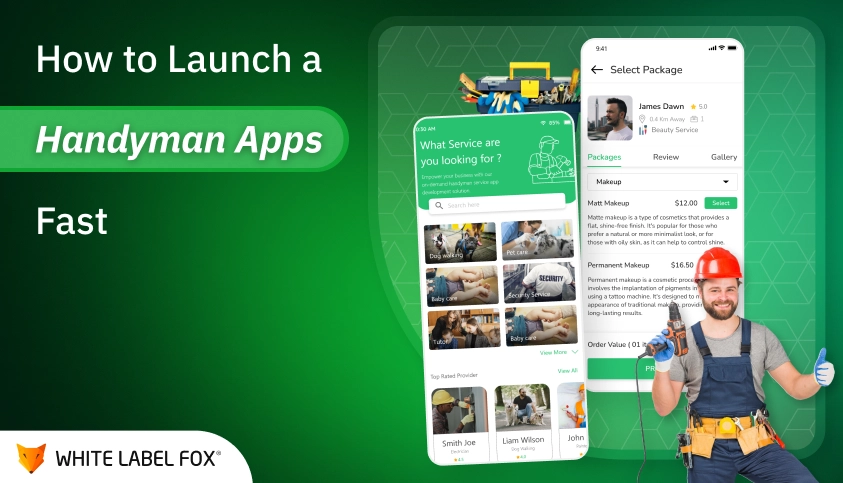Smart home manager apps will be an essential tool for every future home as more and more people are moving forward with smart devices. The global market capital of smart home devices is already valued at US $84.5 billion in 2024. That’s a huge market size, indicating that people are already exploring the smart device segment.
Increased demand for smart home devices also raises some managing concerns. Users often find it hard to manage all the devices simultaneously and need a tool where they can centrally control everything.
That’s why people opt for smart home manager apps like AT&T for better smart-home tool management. As the number of people using smart tools is increasing, the demand for such apps will surge in the near future. Building a smart home manager app poses a great opportunity for entrepreneurs wanting to establish their digital venture.
The article will give you a deep dive into building a mobile app for smart home management. Learn benefits, essential features, monetization options, and a complete process of creating a smart home manager application like AT&T.
Benefits of Having a Smart Home Manager App
Smart home manager apps are essential for modern residences. They bring everything in one place and allow seamless access to every smart device at your home. Smart device managers turn your phone into a central access point for managing various appliances, even at a distance. Hence, every modern householder seeking digital help to control their smart devices should adopt smart home manager apps. Besides the accessibility and control, you will receive various other benefits.
1. Central Access
Isn’t it nice to control every electrical appliance in your home from a central point? Smart home manager apps allow you to do that. Whether you want to manage your thermostats, lights, or security cameras, smart home managers provide central access to everything, making home management a breeze.
2. Elevated security
Smart home managers provide real-time alerts. No matter where you are, you instantly get notified of any unusual activities on your phone. But remote access doesn’t just stop there. You can also monitor your security cameras, lock and unlock your doors, and access every smart safety tool from your mobile.
3. Energy Saving
Do you always miss turning off electric devices when leaving the house? Worry not. Now, smart home manager devices can turn them off for you. You only need to set schedules for your appliances. The app will turn them off automatically at the scheduled time if you’ve forgotten to do so manually. Moreover, you can also track and manage your energy use. The app provides insights into your energy waste, enabling you to create a strategy to lower your bills.
4. High Convenience
Smart home managers offer great convenience. You can easily adjust your home’s temperature or change lighting. Create routines, automate daily tasks, and make your home as comfortable as possible without any effort.
5. Quick Troubleshooting
WiFi is not working? You can fix it yourself. There is no need to wait for tech support. The smart home manager app allows real-time monitoring and troubleshooting, enabling you to resolve network problems. You can run speed tests, check connections, and ensure your network runs smoothly.
6. Enhanced Child Safety
For parents, smart home managers can be an effective solution. These apps can help you set screen time, restrict unsuitable content access, and keep watch on your child’s internet activity. The app gives you the tools to promote healthy digital habits and ensure your child is safe on the internet.
7. Personalized Experience
Installing the smart home manager app is the first step towards personalizing your smart home experience. These apps allow you to customize your home settings according to your family’s needs. You can create profiles for every family member to prioritize particular devices and fine-tune your network to work your preferred way.
Enhance Your User’s Living Space
Let’s create an Uber-like application and drive your ride-sharing business to success.

Step-By-Step Process of Building an App Like AT&T Smart Home Manager
Building an app like AT&T smart home manager involves many steps. Here, you’ll find a comprehensive outline of steps developers follow to develop a mobile application, with specific tasks done in each phase.
Step #1: Project Ideation
Every software development starts with a solid plan. Developers and business owners sit together to craft a complete project roadmap that clearly states milestones and potential hurdles.
Every smart home manager app development project starts with audience research, where developers define the target audience persona and list their pain points and requirements. The next step involves competitive analysis, where they check out other smart home apps. This analysis is done to learn what competitors are doing well and where they are lacking.
The research phase also involves staying updated with market trends. Learning new and exciting features in the smart home market and incorporating them in your smart home manager app can help you stay ahead of the competition. Once everything is gathered and basic app functionality is decided, the app development process moves forward to creating an app design.
Step #2: UI/UX Design
Design is the phase where your application starts taking form and shape. The design phase defines how your app will look and feel and how your brand should appear. Make sure you choose a subtle color palette that makes your smart home manager app look professional. AT&T’s blue and white colors give it a sleek and modern appearance that appeals to tech-savvy users.
Moreover, its dark-shade backgrounds with white text make elements seamless to see. Blue is associated with peace and tranquility, making users feel more calm and comfortable using the app. So, choose colors that align with your brand and radiate a calming vibe.
A consistent color palette across the smart home manager app reinforces your brand identity. It’s essential to strictly follow your brand colors. Moreover, a simple, uncluttered look helps users focus better. Keep your UI elements as minimal as possible to make your application look clean and professional. Focus on an intuitive and interactive user experience that makes your app appealing and builds your brand.
Step #3: Development
Once the design is finalized, the development process shifts toward the most critical stage – creating the app. In this phase, designers, developers, and testers collaborate to build a smart home manager app like AT&T. The development starts with creating a frontend module, which involves creating buttons, text fields, and other interactive user interfaces.
Backend developers create a server-side structure that supports your app’s functionalities. This stage also involves implementing SDKs and APIs that connect with various smart home devices. Besides this, developers embed security measures such as encryption, authentication, and authorization to protect user information.
Unit and integration testing also go hand-in-hand to identify and resolve issues early on. Developers often use an agile approach for iterative progress. This methodology allows for continuous improvement of the app during the development phase.
Step #4: Testing and Deployment
While preliminary testing is done during the development stage itself, it’s not enough, and extensive testing is needed to double-check that the app performs well. Now, the project goes into the testers’ hands. They implement various testing techniques to ensure smooth operations. Here are the testing methods testers employ during this phase:
- Functional testing:
This technique checks whether all functions work as per software requirements.
- Performance testing:
This technique evaluates the smart home manager app’s speed, responsiveness, and stability under a workload.
- Security testing:
This technique identifies potential security threats in the app.
- Usability testing:
This technique evaluates how easy the smart home manager app is to use.
- Beta testing:
This technique involves releasing the fully functional app version to a small group of users. These users share their experience with the app, enabling developers to identify and rectify issues before launching the main version.
If testers find any bugs while running these testing methods, they inform developers to fix them. The cycle continues until all the bugs are fixed. Once the developer receives a green signal from testers, they prepare for the deployment. The smart home manager app is deployed on its respective app store – Google Play Store for Android apps or Apple App Store for iOS apps – and becomes available for users to download.
Step #5: Post-Launch Maintenance
App development is a continuous process and doesn’t end with deployment. Once the smart home manager app gets deployed on the platform, the business owner’s job is to ensure that the app runs smoothly. As people download your app, they’ll share their feedback on the app store. This feedback helps you understand how your users feel about your app and whether they face any issues.
The app needs regular updates for various reasons. As users continue using the app, they will report new bugs that need to be addressed quickly. Moreover, having a support channel where users can report issues and get queries is crucial. Furthermore, the increasing user base will also need expanded infrastructure so that your smart home manager app runs smoothly.
Essential Features of the Smart Home Manager App
AT&T’s smart home manager app possesses various essential features that enhance user experience and network management. If you want to create an effective app that helps your users maintain a seamless management experience, implement these essential features. The feature list is assorted from must-haves to good-to-have so that you can easily decide which features you should add to the initial version of your app.
1. User-Friendly Interface
A clean user interface is a foremost requirement for a smart home manager. AT&T offers an intuitive UI that makes navigating their application smooth and effortless. Every feature, setting, and option should be labeled and placed right so users can find them easily. It’s also essential to provide users with an app tour when they log in for the first time. Highlighting essential features and describing their work will help users quickly get started with the app.
2. Connected Device Management
It’s crucial to keep checking all the devices connected to your network. This feature allows users to check what devices are connected to their WiFi and how much data they consume. Users can readily identify and remove unauthorized devices and optimize network resources for better performance on all authorized devices.
3. Speed Test & Signal Strength
This feature can help users check their download and upload speed in real-time. The signal strength option helps measure signal strength across your home. Moreover, users get suggestions for the best placement of their routers to avoid dead zones and get even signal strength throughout their houses.
4. Network Diagnostics and Troubleshooting
Network diagnostics and troubleshooting tools offer features to spot connection issues, whether software or hardware-related. These tools also provide step-by-step guides to fix common problems, eliminating the frequent need for calling tech support. Smart home manager apps must have these tools to reduce downtime and maintain stable connections.
5. Parental Control
This is an essential feature for parents whose kids are always on their mobile phones. The smart home manager app should have a parental control feature that offers various tools to keep the kids safe on the internet. Parents can set specific times to control the time to access the internet. This restricts excessive use. Additionally, parents should be able to block inappropriate content and sites, keeping their children away from adult and harmful content.
6. Guest Wifi
Guest WiFi is an additional access point on the same network. Users can create it to let their guests temporarily connect to the WiFi. Guests can access the internet without needing to connect to the main network. Users can create temporary login details for guests and limit the usage and access of their devices. This way, they can maintain a good network strength for regular devices and ensure the security of the main network while being a good host.
7. Profile Management
Profile management allows users to customize their WiFi settings for their home network and devices. Users can create profiles for their different devices and family members. They can also set priority levels to make sure their crucial work devices get better speed. Moreover, users can also customize security settings and bandwidth allocation to increase network efficiency.
8. Chatbot
A chatbot provides quick customer support. Users can ask for troubleshooting tips and get answers to FAQs quickly. Chatbot helps resolve issues without waiting for customer service so everyone can enjoy personalized help that enhances the overall user experience. Moreover, implementing a chatbot in your smart home manager app can ease the customer support burden for you as users can resolve their queries through AI.
9. Wifi Map
This feature offers a visual image of WiFi coverage within the user’s home. Homeowners can get a detailed signal strength analysis around their homes and evaluate the places for weak and strong signals. WiFi maps can also show interface resources or signal obstacles like walls or appliances that may affect the complete coverage, thus helping to optimize router placement and identify areas that need additional WiFi extenders or access points.
10. Seamless Integration with Smart Home Devices
Homeowners can integrate smart home managers with smart devices like thermostats, lights, or security systems. They can control all their gadgets from one place, enhancing the convenience and automation in their daily lives.
11. Customizable Notifications
Smart home managers also keep their owners informed with notifications. Users receive alerts for new device connections or unusual activity within their network. These notifications can be customized according to the user’s preferences, offering a more personalized touch.
12. Gateway Reboot
The smart home manager app allows users to reboot their network gateway or router remotely. Rebooting the gateway can help resolve network issues like connectivity, slow speed, or device disconnects. Moreover, users can initiate a reboot with a single tap and track the progress within the app, eliminating the need to access the router for rebooting.
13. Advanced Security Features
Advanced security features help in protecting networks and data. These features implement strong encryption and security protocols that make networks hard to breach. Moreover, users get alerts for potential security breaches or suspicious activities. Regularly updating security measures can help users eliminate threats and enjoy a secure connection.
Cost of Building a Smart Home Manager App Like AT&T
How much does it cost to build AT&T-like smart home manager apps? There is no straightforward answer to this question because each app development project involves various factors influencing the app development cost. Here’s a list of factors that you may want to keep in mind while determining the valuation of your smart home manager app.
Factors That Influence the Cost of Smart Home Manager App Development
Even though every app development project looks similar, some nuances make them unique, and thus, they have different costs. The app development cost heavily depends on business requirements. Different requirements need different tech stacks, skills, and other factors that add to the difference in pricing. For example, the cost of building an app for house cleaning varies from creating an app for a smart home manager. Thus, it’s essential to take all the factors into account before estimating the cost. Here’s what to consider.
1. App Platform:
What platform you want to build a smart home manager app plays a crucial role in determining its development cost. For example, Android app development is less costlier than iOS app development. Moreover, building an app for a single platform costs less than building for both platforms.
Some developers offer discounts on creating applications for both platforms, reducing a significant expense on app development. You can opt for React Native development as well, which is a less expensive option than native development.
2. Design Complexity:
The complexity of design also plays a crucial role in the cost of building a smart home manager app. Simple and minimalistic layouts are seamless to create, take less time, and need fewer resources. Designers could also utilize pre-built templates to speed up the design process, leading to less expense than customized design.
If the client requires customized, intricate design, it apparently takes more time and resources. Designers need to research and ideate to come up with inspirations to create such custom designs that align with client needs and their brand. The continuous tweaks and changes in the design require more time and hence increase the cost.
3. Features and Functionality:
Features are the essence of any application. Hence, they are also one of the essential cost-influencing factors in app development. Although it goes without saying the more features you want to include in your smart home manager app, the higher the development cost will be, there are some instances where fewer complex features could also increase the expens
Profile management, device management, and speed testing are some of the basic features that could cost less. Complex features like network diagnostics, parental control, and guest WiFi could surge the cost a bit, but if you want to implement advanced functionalities like WiFi map, chatbot, and seamless integration with other smart home manager devices, be ready to pay an exponential price than the basic feature set.
4. Development Team Location:
Your development team’s location also influences the development cost. Here, the rates may also vary by hiring models, but typically, developers charge on an hour-based model. Considering this fact, US developers charge around $100 per hour, while European developers charge around $80.
Indian developers are best in pricing terms, charging around $50 per hour. Besides cost-effectiveness, Indian developers offer quality development compared to other Asian countries. So, if you have a small budget, hiring a development team from India could be a cost-effective option.
5. Development Team Strength:
The number of developers in a team also determines the cost. The more the developers, the higher the development cost will be. This is because a higher number of developers can get the work done in less time while fewer developers take more time to build an app. Thus increasing the cost of building a smart home manager app like AT&T.
6. Maintenance and Updates:
Post-launch app maintenance and updates are necessary to ensure the app runs smoothly. Some companies offer maintenance for free for some time. Such primary maintenance involves bug fixes and security patches. But, if you need additional maintenance services like enhancing features or expanding infrastructure, you might get charged extra, leading to increased development costs.
A Detailed Breakdown of Cost Estimation For Building an AT&T-Like App
Since development cost depends on many factors, we can’t really determine the exact cost without considering particular project requirements. However, we can give you a high-level cost estimation based on features. Let’s quickly go through a detailed breakdown of cost estimation for building a smart home manager app like AT&T.
| Details | Basic App | Complex App | Advanced App |
|---|---|---|---|
| Features: |
Includes essential features like:
|
Includes all basic features plus advanced features like:
|
Includes all basic and advanced features plus premium features like:
|
| Cost: | $50,000 – $100,000 | $100,000 – $200,000 | $200,000 – $500,000+ |
| Suitable For: | Startups or small businesses looking to enter the market with essential features | Mid-size businesses wanting to offer more comprehensive solutions with enhanced functionalities | Established organizations aiming to provide a top-tier smart home management experience with cutting-edge technology. |
Top 6 Monetization Strategies You May Incorporate in Your Smart Home Manager Application
Like every application, your smart home manager app needs a monetization strategy to generate revenue for your business. Deciding a monetization model in the earlier development stage is essential. It helps development to move forward in the right direction. Learn 6 monetization strategies you can implement in your smart home manager application that help you make money.
1. Freemium Model
The freemium model is best for new apps. You can offer initial or basic features for free and keep other features priced. By offering basic functionality for free, you can boost traffic on your app, which is essential for newly launched applications. It’s the best monetization strategy adopted by many leading mobile applications.
2. Subscription Model
Users pay weekly, monthly, or annual fees to use premium features. You can provide different subscription tiers that include various user budgets and requirements. This model offers a steady revenue stream and enhances user engagement and retention for your smart home manager app.
3. In-App Purchase
You can combine this model with a freemium version where you provide primary functions for free and charge for other individual features. You can charge for functionalities like customization options, security features, and multiple device integrations. The In-App purchases model can be cost-effective for users as they only pay for what they use. It boosts user experience by allowing them to purchase individual features they need.
4. Affiliate Marketing
In this model, you partner with other companies through affiliate programs and promote their products or services on your smart home manager app. In return, companies will pay you a commission for every lead generated or sale made. Tie up with firms that offer products or services related to your industry. However, keep your affiliate promotions minimal in a way that does not affect or interfere with your user experience.
5. Advertising
You can integrate ads and generate revenue from sponsored content, display adverts, and video commercials. A smart home manager app can leverage the advertising model by showing relevant ads on energy-saving tips, smart-home products, and home remodeling services. However, ensure you show relevant ads on your app to maintain a positive client experience.
6. Licensing and Partnership
You can also generate revenue by partnering with other companies and allowing them to use your smart home manager app. Internet Service Providers and white-label product manufacturers can customize your application for their clients. Moreover, partnering with smart home appliance manufacturers or service providers can open up new opportunities for creating revenue streams through bundled goods and packaged services.
How We Can Help You Build a Smart Home Manager App Like AT&T
Now you’ve come to a stage where you have extensive knowledge of building a smart home manager app like AT&T. You know why smart home managers are popular, how they benefit its users, what functionalities it should feature to meet the modern user requirements, and what’s the entire process of developing such applications. Now, you have to find the right software development company to bring your app into reality.
As a top-notch on-demand mobile app development company, White Label Fox excels at developing innovative solutions that cater to the masses and help business owners establish their brand in the highly competitive market. We have always been at the forefront of innovation – thanks to our fleet of highly skilled and extensively experienced developers. We have built countless on-demand applications for our global clientele.
Our development team is well-versed in tackling unique business challenges and delivering bespoke solutions that give tough competition in their respective fields. Leave your app development worries to our team to experience the stressless app development process White Label Fox offers. Get in touch with us today and pitch your requirements to get a quick consultation and customized quote for your smart home manager app development.
Frequently Ask Questions
A Smart Home Manager app allows users to control and monitor various
smart devices within their home, such as lights, thermostats, security
cameras, and home appliances, all from a single mobile application. It
acts as a centralized platform for managing connected devices in a smart
home ecosystem.
Key features of a Smart Home Manager app include:
- Device Control: Ability to control lights, thermostats,
locks, and other devices remotely.
- Automation: Set schedules or triggers for devices to
operate automatically.
- Voice Integration: Integration with voice assistants like
Alexa or Google Assistant.
- Security Features: Integration with security cameras,
alarms, and motion sensors.
- User Profiles: Customizable profiles for different users
with specific permissions.
- Notifications: Real-time alerts for device status,
security breaches, or scheduled activities.
- Device Control: Ability to control lights, thermostats, locks, and other devices remotely.
- Automation: Set schedules or triggers for devices to operate automatically.
- Voice Integration: Integration with voice assistants like Alexa or Google Assistant.
- Security Features: Integration with security cameras, alarms, and motion sensors.
- User Profiles: Customizable profiles for different users with specific permissions.
- Notifications: Real-time alerts for device status, security breaches, or scheduled activities.
To build a Smart Home Manager app, you will need:
- Mobile Development Framework: Flutter or React Native for
cross-platform development.
- Cloud Infrastructure: AWS, Google Cloud, or Microsoft
Azure for cloud storage and device management.
- IoT Communication Protocols: MQTT, Zigbee, Z-Wave for
device communication.
- APIs: Integration with third-party smart devices and
services.
- Data Security: Encryption protocols to ensure data
security and privacy.
- Mobile Development Framework: Flutter or React Native for cross-platform development.
- Cloud Infrastructure: AWS, Google Cloud, or Microsoft Azure for cloud storage and device management.
- IoT Communication Protocols: MQTT, Zigbee, Z-Wave for device communication.
- APIs: Integration with third-party smart devices and services.
- Data Security: Encryption protocols to ensure data security and privacy.
To integrate smart devices with the app, you’ll need to establish
connections through compatible IoT platforms or use device-specific
APIs. This allows the app to communicate with the devices and send
commands (e.g., turning on/off lights or adjusting temperature
settings).
Some common challenges include:
- Compatibility: Ensuring compatibility with a wide range
of devices from different manufacturers.
- Security: Protecting user data and ensuring that devices
are safe from hacking attempts.
- User Experience: Creating an intuitive and
easy-to-navigate interface for controlling complex devices.
- Scalability: Designing the app to support the addition of
new devices and features over time.
- Compatibility: Ensuring compatibility with a wide range of devices from different manufacturers.
- Security: Protecting user data and ensuring that devices are safe from hacking attempts.
- User Experience: Creating an intuitive and easy-to-navigate interface for controlling complex devices.
- Scalability: Designing the app to support the addition of new devices and features over time.
The cost of developing a Smart Home Manager app can vary based on
several factors:
- Complexity of Features: Basic control features will be
less expensive than a full-fledged app with advanced features
like AI and voice control.
- Platform: Developing for both iOS and Android will cost
more than a single platform.
- Integration with Smart Devices: The number and type of
devices to integrate with can impact costs.
- Development Team: The expertise and location of the
development team can affect pricing.
- Complexity of Features: Basic control features will be less expensive than a full-fledged app with advanced features like AI and voice control.
- Platform: Developing for both iOS and Android will cost more than a single platform.
- Integration with Smart Devices: The number and type of devices to integrate with can impact costs.
- Development Team: The expertise and location of the development team can affect pricing.
To ensure security:
- Implement end-to-end encryption for data transmission.
- Use two-factor authentication for user logins.
- Regularly update the app to patch any security vulnerabilities.
- Secure communication protocols such as HTTPS and
SSL/TLS for device interaction.
- Conduct security audits and penetration testing to
identify potential vulnerabilities.
- Implement end-to-end encryption for data transmission.
- Use two-factor authentication for user logins.
- Regularly update the app to patch any security vulnerabilities.
- Secure communication protocols such as HTTPS and SSL/TLS for device interaction.
- Conduct security audits and penetration testing to identify potential vulnerabilities.
You can monetize a Smart Home Manager app through:
- Freemium Model: Offer basic features for free, with
premium features available for a fee (e.g., advanced automation
or integration with additional devices).
- Subscription Model: Charge users a recurring subscription
fee for premium services, cloud storage, or additional devices.
- Advertising: Display ads within the app, especially if
the app has a large user base.
- Device Partnerships: Partner with smart device
manufacturers to offer exclusive deals or bundles to users.
- Freemium Model: Offer basic features for free, with premium features available for a fee (e.g., advanced automation or integration with additional devices).
- Subscription Model: Charge users a recurring subscription fee for premium services, cloud storage, or additional devices.
- Advertising: Display ads within the app, especially if the app has a large user base.
- Device Partnerships: Partner with smart device manufacturers to offer exclusive deals or bundles to users.
To stay ahead in the competitive market:
- Offer innovative features that competitors do not
provide, such as AI-driven automation or unique integrations.
- Ensure the app is user-friendly and intuitive.
- Provide excellent customer support and prompt updates.
- Focus on privacy and security, which are crucial concerns
for smart home users.
- Partner with top-tier smart device manufacturers to ensure
compatibility and exclusive features.
- Offer innovative features that competitors do not provide, such as AI-driven automation or unique integrations.
- Ensure the app is user-friendly and intuitive.
- Provide excellent customer support and prompt updates.
- Focus on privacy and security, which are crucial concerns for smart home users.
- Partner with top-tier smart device manufacturers to ensure compatibility and exclusive features.

















